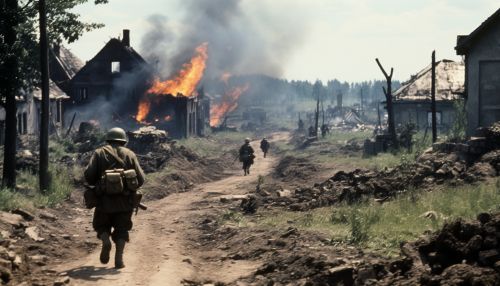Eastern Front (World War II)
Prelude
The Eastern Front of World War II was a theatre of conflict between the European Axis powers, led by Nazi Germany, and the Soviet Union, which encompassed central and eastern Europe from 22 June 1941 to 9 May 1945. It was the largest theatre of the war, including some of the war's most significant battles, and was notorious for its unprecedented ferocity, destruction, and immense loss of life.
Background
The Eastern Front was initiated by Germany with the invasion of the Soviet Union on 22 June 1941, with the strategic goal of capturing the European part of the Soviet Union and the destruction of the Soviet regime. The Axis powers were initially successful, capturing vast territories and inflicting enormous losses on the Red Army. However, the tide of the war gradually turned in favour of the Soviet Union, which eventually pushed the Axis powers out of its territory and advanced into Eastern Europe.
Operation Barbarossa
Operation Barbarossa was the code name for the Axis invasion of the Soviet Union, which started on Sunday, 22 June 1941. The operation was named after Frederick Barbarossa, the medieval German emperor who led the Third Crusade in the 12th century. The operation was driven by Adolf Hitler's ideological desire to conquer the Soviet territories as outlined in his 1925 manifesto Mein Kampf.


The Siege of Leningrad
The siege of the city of Leningrad (now Saint Petersburg) was a prolonged military blockade undertaken by the German Army Group North against the Soviet city from 8 September 1941 to 27 January 1944. The siege lasted 872 days, or just under two and a half years, making it one of the longest and most destructive sieges in history.
Battle of Stalingrad
The battle was fought between the Axis powers and the Soviet Union for control of the city of Stalingrad (now Volgograd) in Southern Russia. Marked by fierce close-quarters combat and direct assaults on civilians in air raids, it is often regarded as one of the single largest and bloodiest battles in the history of warfare.
The Turning Point
The tide of the war on the Eastern Front shifted with the Soviet victory at the Battle of Stalingrad in February 1943. The defeat of the German Sixth Army at Stalingrad was a severe blow to Germany's military capacity and morale and marked the beginning of a sustained Soviet offensive that would eventually see the Red Army capture Berlin in May 1945.
Conclusion
The Eastern Front was the decisive theatre of World War II in Europe. The enormous scale and brutality of the conflict on the Eastern Front was unprecedented, resulting in enormous loss of life and destruction of property. The outcome of the conflict on the Eastern Front was instrumental in determining the outcome of World War II as a whole.
